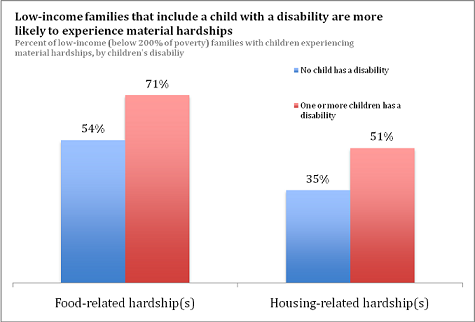December 19, 2012
Shawn Fremstad and Rebecca Vallas
Spotlight on Poverty and Opportunity, December 19, 2012
See article on original website
For children with severe disabilities, parents are the “first responders.” It’s easy to forget that society didn’t always expect so much from these parents. In the early 1960s, some 70 percent of the public thought people with disabilities should be cared for in institutions rather than at home. Fortunately, public attitudes have changed and we have shifted to a system of family- and community-centered care for disabled children and adults.
But like all first responders, parents need support. To help parents provide their disabled children with the best care possible, we need to maintain and strengthen Supplemental Security Income.
There’s no dodging the reality that caring for children with disabilities can be an expensive undertaking. A recent report conducted for the Brookings-Princeton journal Future of Children found that parents caring for disabled children bear additional costs of approximately $6,000 per year, and up to more than $20,000 for the most impaired children.
Working-class families bear the heaviest costs as a share of household income, and face particular hardships. As Susan Parish and her colleagues have shown, among low-income families, those that include a disabled child are much more likely to experience material hardships.

The burdens of caring for a severely disabled child can also take their toll on the bonds that hold parents and families together, as sociologist Dennis Hogan documents in his important book Family Consequences of Children’s Disability. In the three years after the birth of a disabled child, married parents are more likely to separate or divorce.
Congress didn’t have this data when it established Supplemental Security 40 years ago this year. But lawmakers still knew then, as the original House Ways and Means Committee’s report on the legislation founding Supplemental Security stated, that “disabled children living in low-income households are among the most disadvantaged of all Americans and are deserving of special assistance.”
That’s why Supplemental Security is nothing short of vital to families caring for kids with severe disabilities. This is just as true today as it was 40 years ago.
Moreover, we know two very important things about Supplemental Security from careful research.
First, we have clear evidence for what we call the three R’s of Supplemental Security—it Reduces child poverty, Reinforces parental employment by providing the right incentives, and Reduces reliance on other means-tested benefits for families caring for kids with severe disabilities.
Second, when Supplemental Security benefits have been cut for children with intellectual and development disabilities – especially the kinds that one pundit recently downgraded to “fuzzy” disabilities – those children and their families suffer.
Like any successful social initiative, there’s room for improvement. But we should build on the solid foundation Supplemental Security – and related investments like Medicaid and the Individuals with Disabilities Education Act – provides, not tear it down.
As we move forward, there are several points to keep in mind.
First, even with today’s polarized politics, there should be broad support for easing Supplemental Security’s penalties on savings, further expanding work and education supports for youth with disabilities, and providing the Social Security Administration (SSA) with the administrative funding it needs to conduct timely medical reviews of children. These improvements have upfront costs, but are wise investments that pay for themselves over time.
Next, we should resist calls for radical policy change based on stereotypes about parents in disadvantaged places or baseless claims that expenditures on Supplemental Security are rising at an unsustainable pace. In fact, both the Congressional Budget Office and SSA project that expenditures on Supplemental Security will soon begin to decline as a share of GDP.
Finally, beyond Supplemental Security, the United States needs to do much more to promote security and opportunity for parents and young people—with and without disabilities. Both paid parental leave and the EITC should be part of this effort.
At the end of the day, Supplemental Security makes an enormous difference in the lives of vulnerable families. Just take the case of Will Bentley of Covington, Kentucky. Will’s mother, Katie, left her job to stay home with him when it was discovered that Will had lesions on his brain. Caring for Will had become a full-time job. In Katie’s words, “SSI allowed me and my husband to focus on what Will needed. At one time Will was unable to do anything for himself. Now he can read, feed himself, and zip his own jacket. SSI was a vital part of making that a reality.”
The importance of this vital support is clear from stories like Will’s. This need was clear 40 years ago, and SSI’s value as a life-changing investment in our nation’s children with disabilities has only increased over time. Supplemental Security must be strengthened, or it is children and families who will suffer.
Shawn Fremstad is a senior research associate at the Center for Economic and Policy Research. Rebecca Vallas is an attorney and policy advocate at Community Legal Services and co-chair of the national SSI Coalition for Children and Families.






